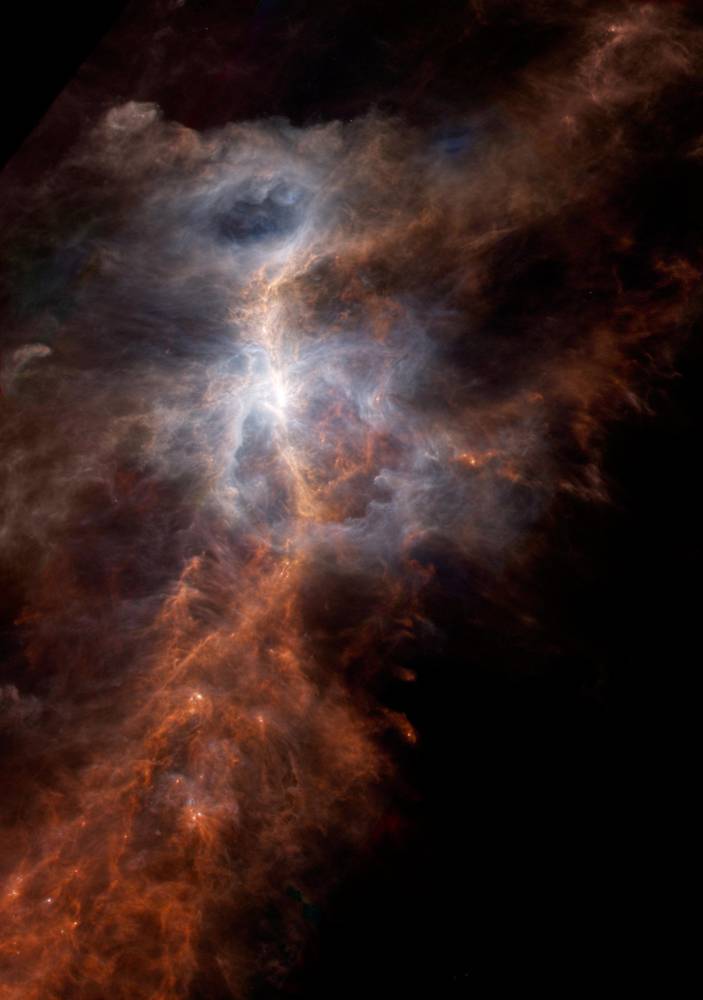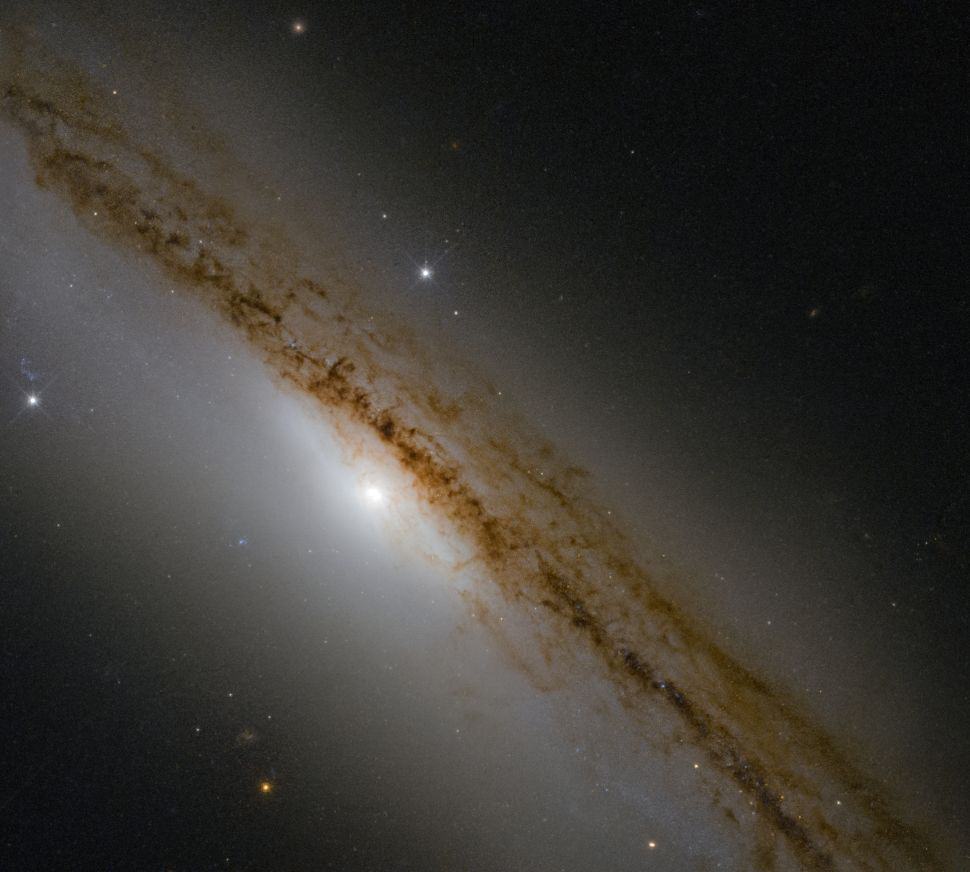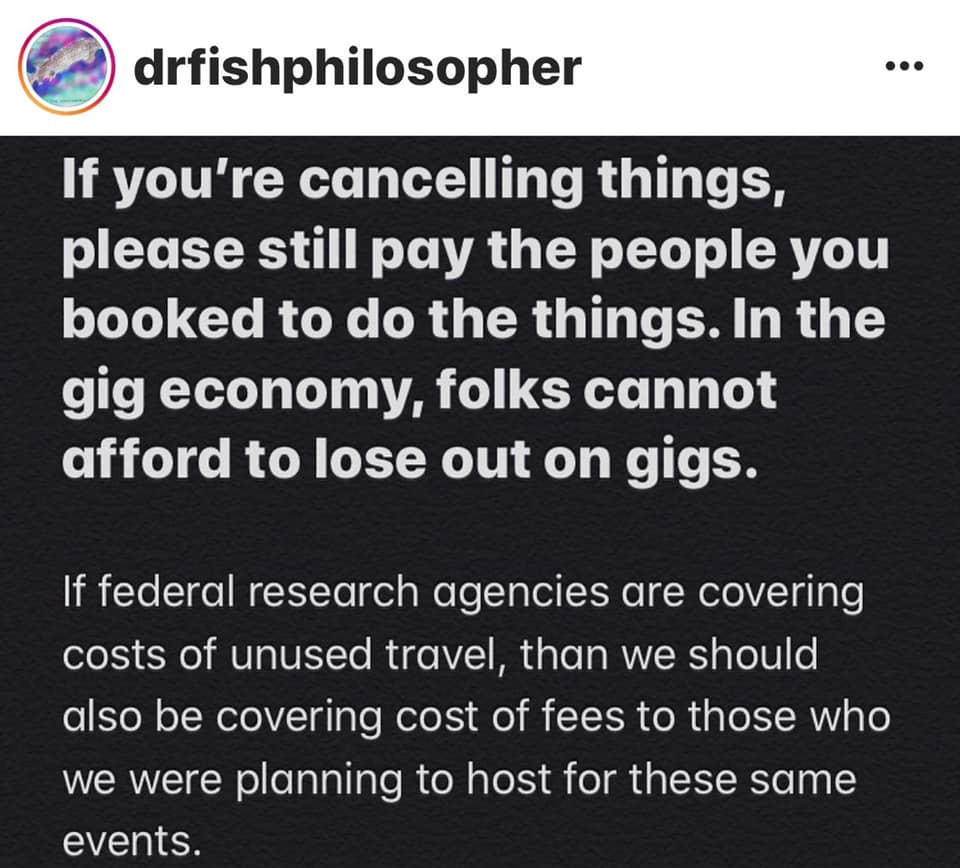Blog
Our last get together day of striking the set of Urinetown at Illusion Theater by Theater 55. Sunday March 15h 2020.
more...This infrared image of the Orion nebula allows astronomers to see dust that’s aglow from star formation. The central light-blue region is the hottest part of the nebula, and as the byproducts of the star factory are ejected out, they cool off and appear red. The Orion Nebula (also known as Messier 42, M42, or NGC 1976) is a diffuse nebula situated in the Milky Way, being south of Orion’s Belt in the constellation of Orion. It is one of the brightest nebulae, and is visible to the naked eye in the night sky. M42 is located at a distance of 1,344 ± 20 light years and is the closest region of massive star formation to Earth. The M42 nebula is estimated to be 24 light years across. It has a mass of about 2,000 times that of the Sun. Older texts frequently refer to the Orion Nebula as the Great Nebula in Orion or the Great Orion Nebula.

Jerry Jeff Walker (born Ronald Clyde Crosby; March 16, 1942, Oneonta, New York, United States) is an American country music singer and songwriter. He is best known for writing “Mr. Bojangles“.
Walker’s maternal grandparents played for square dances in the Oneonta area, with his grandmother, Jessie Conroe, playing piano, and grandfather playing fiddle. During the late 1950s, Crosby was a member of a local Oneonta teen band called The Tones.
The band traveled to Philadelphia to audition for Dick Clark‘s American Bandstand, but were turned down. Members of the band found Dick Clark’s house and were able to get a recommendation to audition at New York City‘s Baton Records through the company’s lead producer Sol Rabinowitz. The band was given a recording contract, but the studio wanted a quintet backed by studio musicians, which left Crosby and another member (Gerald T. Russell) out of their recordings.
After high school, Crosby joined the National Guard, but his thirst for adventure led him to go AWOL and roam the country busking for a living in New Orleans and throughout Texas, Florida, and New York, often accompanied by H.R. Stoneback (a friendship referenced in 1970’s “Stoney”). He played mostly ukulele until Harriet Ottenheimer, one of the founders of The Quorum, got him settled on a guitar in 1963. He adopted his stage name “Jerry Jeff Walker” in 1966.
more...Frederick Neil (March 16, 1936 – July 7, 2001) was an American folk singer-songwriter in the 1960s and early 1970s. He did not achieve commercial success as a performer and is mainly known through other people’s recordings of his material – particularly “Everybody’s Talkin’“, which became a hit for Harry Nilsson after it was used in the film Midnight Cowboy in 1969. Though highly regarded by contemporary folk singers, he was reluctant to tour and spent much of the last 30 years of his life assisting with the preservation of dolphins.
Born in Cleveland, Ohio, and raised in St. Petersburg, Florida, Neil was exposed to music at an early age, travelling around the US with his father, who was a representative for Wurlitzer jukeboxes. Neil was one of the singer-songwriters who worked out of New York City‘s Brill Building, a center for music industry offices. While composing at the Brill Building for other artists, Neil also recorded six mostly rockabilly-pop singles for different labels as a solo artist. He wrote songs that were taken by early rock and roll artists such as Buddy Holly (“Come Back Baby” 1958) and Roy Orbison(“Candy Man” 1961).
more...Minoru Miki (三木 稔 Miki Minoru; 16 March 1930 – 8 December 2011) was a Japanese composer and artistic director, particularly known for his promotional activities in favor of Japanese (as well as Chinese and Korean) traditional instruments and some of their performers. His vast catalogue, where aforementioned traditional instruments figure profusely either solo or in various types of ensemble with or without Western instruments, demonstrates large stylistic and formal diversity. It includes operas and several types of stage music as well as orchestral, concerto, chamber and solo music, and music for films. Miki was probably the second best known Japanese composer overseas after Tōru Takemitsu.
He was a pioneer in the composition of contemporary classical music for large ensembles of traditional Japanese musical instruments. In 1964 he founded the Nihon Ongaku Shūdan (Pro Musica Nipponia ensemble), also known as Ensemble Nipponia, for which he has composed extensively.
Miki was born in Tokushima in 1930, and his first musical experiences were connected with the traditional music of his region. He had no formal music education before he moved to Okayama for high school, where he first had contact with European classical music. From there he moved to Tokyo, graduating from Tokyo University of the Arts in 1964. That year, Miki founded Pro musica Nipponia.
more...Thomas Lee Flanagan (March 16, 1930 – November 16, 2001) was an American jazz pianist and composer. He grew up in Detroit, initially influenced by such pianists as Art Tatum, Teddy Wilson, and Nat King Cole, and then by the newer bebop musicians. Within months of moving to New York in 1956, he had recorded with Miles Davis and on Sonny Rollins‘ landmark Saxophone Colossus. Recordings under various leaders, including the historically important Giant Steps of John Coltrane, and The Incredible Jazz Guitar of Wes Montgomery, continued well into 1962, when he became vocalist Ella Fitzgerald‘s full-time accompanist. He worked with Fitzgerald for three years until 1965, and then in 1968 returned to be her pianist and musical director, this time for a decade.
After leaving Fitzgerald in 1978, Flanagan then attracted praise for the elegance of his playing, which was principally in trio settings when under his own leadership. In his 45-year recording career, he recorded more than three dozen albums under his own name and more than 200 as a sideman. By the time of his death, he was one of the most widely admired jazz pianists and had influenced both his contemporaries and later generations of players.
Flanagan was born in Conant Gardens, Detroit, Michigan, on March 16, 1930. He was the youngest of six children – five boys and a girl. His parents were both originally from Georgia.
more...Alvin “Junior” Raglin (March 16, 1917 – November 10, 1955) was an American swing jazz double-bassist.
Raglin started out on guitar but had picked up bass by the mid-1930s. He played with Eugene Coy from 1938 to 1941 in Oregon, and then joined Duke Ellington‘s Orchestra, where he replaced Jimmy Blanton. Raglin remained in Ellington’s employ from 1941 to 1945.
After leaving Ellington’s orchestra, Raglin led his own quartet, and also played with Dave Rivera, Ella Fitzgerald, and Al Hibbler. He briefly returned to perform with Ellington in 1946 and 1955. Raglin fell ill in the late 1940s and quit performing; he died in 1955 at age 38. He never recorded as a leader.
more...Friday, March 13, 2020: A new Hubble Space Telescope image of the spiral galaxy NGC 1589 reveals the galaxy’s bright central bulge, where a supermassive black hole is lurking in a group of tightly packed stars. The galaxy “was once the scene of a violent bout of cosmic hunger pangs,” Hubble astronomers said in a statement. Located 168 million light-years from Earth in the Taurus constellation, NGC 1589 was discovered by William Herschel in 1783. “As astronomers looked on, a poor, hapless star was seemingly torn apart and devoured by the ravenous supermassive black hole at the center of the galaxy,” the Hubble team said. Now astronomers are using Hubble to look for any evidence of stellar debris that was ejected when the star ripped apart.

more...
Ryland Peter Cooder (born March 15, 1947) is an American musician, songwriter, film score composer and record producer. He is a multi-instrumentalist but is best known for his slide guitar work, his interest in roots music from the United States, and his collaborations with traditional musicians from many countries.
Cooder’s solo work draws upon many genres. He has played with John Lee Hooker, Captain Beefheart, Gordon Lightfoot, Ali Farka Touré, Eric Clapton, The Rolling Stones, Van Morrison, Neil Young, Randy Newman, Linda Ronstadt, David Lindley, The Chieftains, The Doobie Brothers, and Carla Olson & the Textones (on record and film). He formed the band Little Village. He also produced the Buena Vista Social Club album (1997), which became a worldwide hit. Wim Wenders directed the documentary film of the same name (1999), which was nominated for an Academy Award in 2000.
Cooder was ranked eighth on Rolling Stone magazine’s 2003 list of “The 100 Greatest Guitarists of All Time” (David Fricke’s Picks). A 2010 ranking by Gibson placed him at number 32. Cooder was born in Los Angeles, California, to father Bill Cooder and Italian-American mother Emma Casaroli. He grew up in Santa Monica, California, and graduated from Santa Monica High School in 1964.
more...Sly Stone (born Sylvester Stewart; March 15, 1943) is an American musician, songwriter, and record producer who is most famous for his role as frontman for Sly and the Family Stone, a band that played a critical role in the development of soul, funk, rock, and psychedelia in the 1960s and 1970s.
Raised in California, Stone mastered several instruments at an early age and performed gospel music as a child with siblings (and future bandmates) Freddie and Rose. In the mid-1960s, he worked as both a record producer for Autumn Records and a disc jockey for San Francisco radio station KSOL, In 1966, Stone formed Sly & the Family Stone, among the first racially integrated, male and female acts in popular music. The group would score hits such as “Dance to the Music” (1968), “Everyday People” (1968), “Thank You (Falettinme Be Mice Elf Agin)” (1969) and “Family Affair” (1971) and acclaimed albums such as Stand! (1969) and There’s a Riot Goin’ On (1971).
By the mid-1970s, Stone’s drug problems and erratic behavior effectively ended the group, leaving him to record several unsuccessful solo albums. In 1993, he was inducted into the Rock and Roll Hall of Fame as a member of the group.
The Stewart family was a deeply religious middle-class household from Denton, Texas. Born March 15, 1943, before the family had moved from Denton, Texas to Vallejo, California, in the North Bay of the San Francisco Bay Area, Sylvester was the second of the family’s five children.
https://www.youtube.com/watch?v=Hj6OyIh7GAI
more...Philip Chapman Lesh (born March 15, 1940) is an American musician and a founding member of the Grateful Dead, with whom he played bass guitar throughout their 30-year career.
After the band’s disbanding in 1995, Lesh continued the tradition of Grateful Dead family music with side project Phil Lesh and Friends, which paid homage to the Dead’s music by playing their originals, common covers, and the songs of the members of his band. Lesh operates a music venue called Terrapin Crossroads. He scaled back his touring regimen in 2014 but continues to perform with Phil Lesh & Friends at select venues. From 2009 to 2014, he performed in Furthur alongside former Grateful Dead bandmate Bob Weir.
Lesh was born in Berkeley, California, and started out as a violin player. While enrolled at Berkeley High School, he switched to trumpet and participated in all of the school’s music-related extracurricular activities. Studying the instrument under Bob Hansen, conductor of the symphonic Golden Gate Park Band, he developed a keen interest in avant-garde classical music and free jazz. After attending San Francisco State University for a semester, Lesh was unable to secure a favorable position in the school’s band or orchestra and determined that he was not ready to pursue a higher education. Upon dropping out, he successfully auditioned for the renowned Sixth Army Band (then stationed at the Presidio of San Francisco) with the assistance of Hansen but was ultimately determined to be unfit for military service.
more...Charles Lloyd (born March 15, 1938) is an American jazz musician. Though he primarily plays tenor saxophone and flute, he has occasionally recorded on other reed instruments, including alto saxophone and the Hungarian tárogató. Lloyd’s band since 2007 includes pianist Jason Moran, bassist Reuben Rogers, and drummer Eric Harland.
In 1956 Lloyd left Memphis for Los Angeles to earn a degree in music at the University of Southern California, where he studied with Halsey Stevens, whose speciality was Bartók. At night, he played in jazz clubs with Ornette Coleman, Billy Higgins, Scott LaFaro, Don Cherry, Charlie Haden, Eric Dolphy, Bobby Hutcherson and other leading west coast jazz artists. He also was a member of the Gerald Wilson big band.
more...Samuel John “Lightnin’” Hopkins (March 15, 1912 – January 30, 1982) was an American country blues singer, songwriter, guitarist and occasional pianist, from Centerville, Texas. Rolling Stone magazine ranked him number 71 on its list of the 100 greatest guitarists of all time.
The musicologist Robert “Mack” McCormick opined that Hopkins is “the embodiment of the jazz-and-poetry spirit, representing its ancient form in the single creator whose words and music are one act”.
Hopkins was born in Centerville, Texas, and as a child was immersed in the sounds of the blues. He developed a deep appreciation for this music at the age of 8, when he met Blind Lemon Jefferson at a church picnic in Buffalo, Texas. That day, Hopkins felt the blues was “in him”. He went on to learn from his older (distant) cousin, the country blues singer Alger “Texas” Alexander.(Hopkins had another cousin, the Texas electric blues guitarist Frankie Lee Sims, with whom he later recorded.) Hopkins began accompanying Jefferson on guitar at informal church gatherings. Jefferson reputedly never let anyone play with him except young Hopkins, and Hopkins learned much from Jefferson at these gatherings.
In the mid-1930s, Hopkins was sent to Houston County Prison Farm; the offense for which he was imprisoned is unknown. In the late 1930s, he moved to Houston with Alexander in an unsuccessful attempt to break into the music scene there. By the early 1940s, he was back in Centerville, working as a farm hand.
Hopkins took a second shot at Houston in 1946. While singing on Dowling Street in Houston’s Third Ward (which would become his home base), he was discovered by Lola Anne Cullum of Aladdin Records, based in Los Angeles. She convinced Hopkins to travel to Los Angeles, where he accompanied the pianist Wilson Smith. The duo recorded twelve tracks in their first sessions in 1946. An Aladdin executive decided the pair needed more dynamism in their names and dubbed Hopkins “Lightnin'” and Wilson “Thunder”.
more...As life in Italy grinds to a halt amid a nationwide lockdown to control the spread of the coronavirus outbreak, one street was filled with song as the community banded their voices together in solidarity.
A video of people singing out of their windows on a neighbourhood street in Siena, Tuscany, went viral on social media, with many calling it a “beautiful” act of humanity. “People of my hometown Siena sing a popular song from their houses along an empty street to warm their heart during the Italian Covid-19lockdown”. The song, titled ‘Canto della Verbena’ (‘And While Siena Sleeps’), is a popular folk song in the city typically sung to express local pride. It focuses on the Piazza del Campo, the main square of the city, and is traditionally sung by members of a contrada, districts set up in the Middle Ages to supply troops. Social media users were deeply touched by the communal singing, with some admitting it brought them to tears.“People breaking out in song, lifting each other’s spirits during this tragedy, is an act of striking beauty,” said one person. “It’s a reminder that, especially during a tragedy, the human spirit keeps us all going in hope. We shine our best in the darkness. Thank you, Siena. You made my day.”Another said: “Reminiscent of the chants from Wuhan high-rise apartments early in the epidemic there. Stay strong Italy. Praying for you guys.” The lockdown in Italy has effectively quarantined nearly 16 million people and shut down all shops except supermarkets and pharmacies.

More Posts
- Vassar Clements Day
- Albert King Day
- Ella Fitzgerald Day
- Earl Bostic Day
- World Music with Toumani Diabaté & Salif Keita
- Daily Roots with Osmond Collins
- Music for Surviving the Pandemic
- The Cosmos with NGC 2014
- Frank Strazzeri Day
- Joe Henderson Day
- Johnny Griffin Day
- Flamenco Fridays with Paco de Lucia
- Daily Roots with Princess Kazayah
- Music for Surviving the Pandemic
- The Cosmos with NGC 7000 Lyrid Meteor
- Roy Orbison Day
- Bunky Green Day
- Charles “Cow Cow” Davenport Day
- Jimmie Noone Day
- World Music with Aditya Prakash
